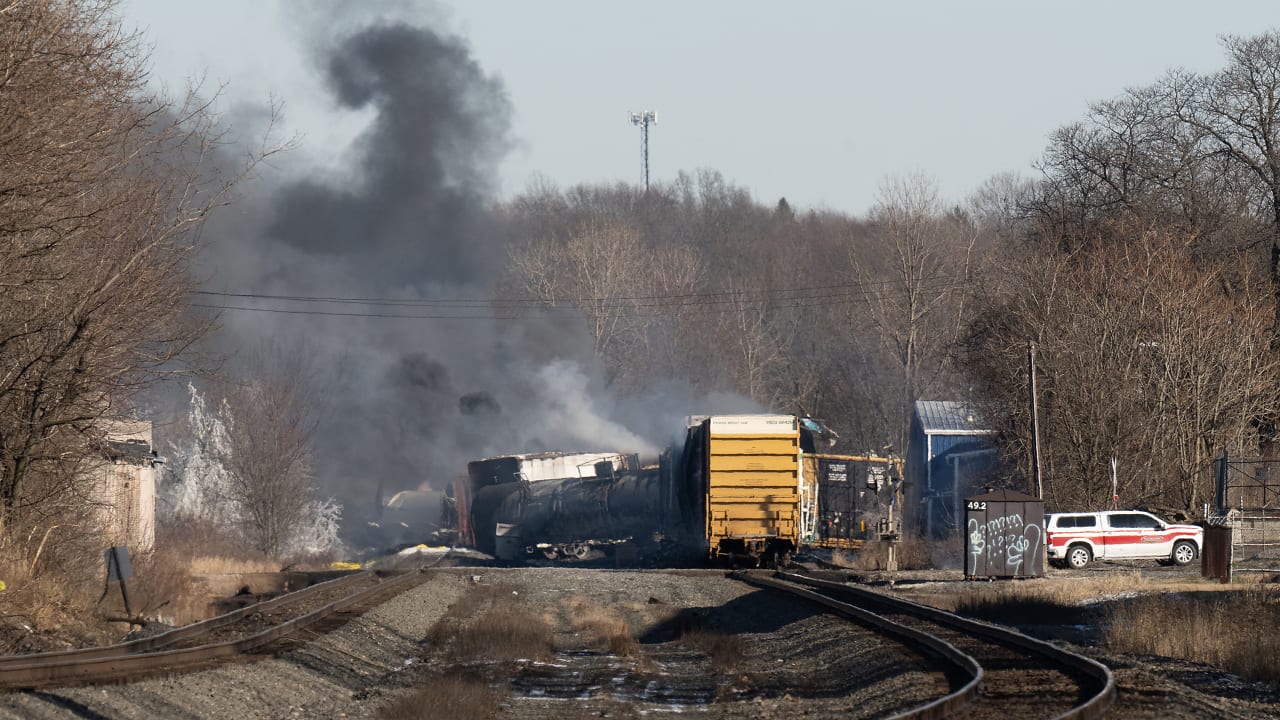Months-Long Persistence Of Toxic Chemicals After Ohio Train Derailment

Table of Contents
The Nature and Persistence of Released Chemicals
The Ohio train derailment involved the release of several hazardous chemicals, most notably vinyl chloride, butyl acrylate, and ethylhexyl acrylate. These chemicals present significant health risks and exhibit varying degrees of persistence in the environment.
-
Vinyl chloride: This colorless gas is a known carcinogen, linked to liver cancer, brain tumors, and other serious health problems. Its relatively short half-life in the air doesn't fully alleviate concerns, as its breakdown products can also be harmful.
-
Butyl acrylate and Ethylhexyl acrylate: These acrylates are used in paints and plastics. They are irritants to the skin, eyes, and respiratory system, and their long-term environmental effects are still being studied. Their persistence in soil and water is a major concern.
-
Slow Breakdown Rates: The rate at which these chemicals break down in the environment depends on several factors, including temperature, soil type, sunlight exposure, and microbial activity. Many of these chemicals have relatively slow degradation rates, meaning they can persist in the environment for months, or even years, leading to long-term contamination.
-
Bioaccumulation: A crucial concern is the potential for bioaccumulation. These chemicals can accumulate in living organisms, moving up the food chain and potentially reaching concentrations harmful to wildlife and humans consuming contaminated food sources. This poses a considerable threat to the local ecosystem and food security.
Contamination of Water and Soil Resources
The Ohio train derailment resulted in widespread contamination of water and soil resources in the East Palestine area and beyond.
-
Water Pollution: Nearby waterways, including waterways like Leslie Run and the Ohio River, were significantly impacted, with reports of contaminated surface water and concerns about groundwater contamination. The long-term effects on aquatic life and the potential for contamination of drinking water supplies remain a major concern. Water testing continues to reveal the presence of these chemicals months after the initial incident.
-
Groundwater Contamination: The infiltration of contaminated water into groundwater aquifers poses a particularly serious threat. Groundwater is a primary source of drinking water for many communities, and its contamination could have long-lasting impacts. The precise extent of groundwater contamination is still being assessed.
-
Agricultural Impact: The contamination of agricultural lands presents significant risks to crops and livestock. Exposure to contaminated soil and water can lead to reduced crop yields and potentially contaminate food products. The long-term impact on agricultural productivity in the affected areas is still uncertain.
-
Remediation Challenges: Cleaning up contaminated soil and water is a complex and expensive undertaking. The processes involved, such as excavation, bioremediation, and water treatment, are time-consuming and may not fully eliminate all contaminants.
Health Impacts and Long-Term Risks
The release of toxic chemicals from the Ohio train derailment has raised serious concerns about the immediate and long-term health consequences for residents of East Palestine and surrounding areas.
-
Reported Health Issues: Residents have reported a range of symptoms, including respiratory problems, headaches, skin rashes, and nausea. The long-term effects of exposure to these chemicals remain unclear, and ongoing health monitoring is crucial.
-
Cancer Risk: Many of the released chemicals are known or suspected carcinogens, significantly increasing the risk of various cancers in exposed individuals. Long-term epidemiological studies will be needed to fully assess the extent of this risk.
-
Neurological Effects: Some of the chemicals released can affect the nervous system, leading to neurological problems such as impaired cognitive function and other debilitating conditions.
-
Reproductive Health: Concerns exist regarding the impact on reproductive health, with potential risks to both the fertility of adults and the development of children exposed to these chemicals in utero or during early childhood.
-
Need for Comprehensive Monitoring: A comprehensive, long-term health monitoring program is essential to track the health status of exposed populations and identify any long-term health impacts.
The Ongoing Cleanup Efforts and Their Effectiveness
The cleanup efforts following the Ohio train derailment are ongoing, involving a coordinated response from government agencies, private companies, and community organizations.
-
Remediation Strategies: These efforts include the removal of contaminated soil, the treatment of contaminated water, and the implementation of air monitoring systems.
-
Effectiveness Evaluation: The long-term effectiveness of these cleanup efforts is still to be determined. Complete remediation may be challenging, given the persistence of some of the released chemicals and the complex nature of the contamination.
-
Challenges in Cleanup: The scale of the contamination and the complexities of soil and water remediation pose significant challenges. Factors such as the varied permeability of the soil and the unpredictable behavior of the chemicals in the environment contribute to the difficulty of cleanup.
-
Community Involvement: Community involvement and transparent communication are critical for building trust and ensuring that cleanup efforts address the concerns of residents.
Conclusion
The Ohio train derailment’s impact extends far beyond the immediate aftermath. The months-long persistence of toxic chemicals highlights the critical need for comprehensive, long-term monitoring and remediation efforts. The ongoing health risks and environmental contamination demand sustained attention and resources. Understanding the long-term consequences of the Ohio train derailment is crucial for preventing future disasters. Stay informed about the ongoing situation, demand accountability from responsible parties, and advocate for stronger regulations to prevent future incidents involving the transportation of hazardous materials. Learn more about the persistent effects of toxic chemicals after the Ohio train derailment and get involved in advocating for environmental protection and stronger regulations concerning the transport of hazardous materials.

Featured Posts
-
 Dexter Resurrection Fan Favorite Villains Comeback
May 22, 2025
Dexter Resurrection Fan Favorite Villains Comeback
May 22, 2025 -
 The Baldoni Feud Blake Livelys Alleged Blackmail Of Taylor Swift Using Leaked Personal Texts
May 22, 2025
The Baldoni Feud Blake Livelys Alleged Blackmail Of Taylor Swift Using Leaked Personal Texts
May 22, 2025 -
 From Office Romance To Corporate Scandal A Ceos Cautionary Tale
May 22, 2025
From Office Romance To Corporate Scandal A Ceos Cautionary Tale
May 22, 2025 -
 Racial Hatred Tweet Ex Councillors Wife Seeks Sentence Appeal
May 22, 2025
Racial Hatred Tweet Ex Councillors Wife Seeks Sentence Appeal
May 22, 2025 -
 Closure Of Anchor Brewing Company Impact On The Craft Beer Industry
May 22, 2025
Closure Of Anchor Brewing Company Impact On The Craft Beer Industry
May 22, 2025
Latest Posts
-
 Nyt Wordle April 12 2024 Hints Solution And Help For 1393
May 22, 2025
Nyt Wordle April 12 2024 Hints Solution And Help For 1393
May 22, 2025 -
 Todays Nyt Wordle Hints Answer And Help April 8 1389
May 22, 2025
Todays Nyt Wordle Hints Answer And Help April 8 1389
May 22, 2025 -
 Gas Prices In Columbus Ohio Current Range And Savings Tips
May 22, 2025
Gas Prices In Columbus Ohio Current Range And Savings Tips
May 22, 2025 -
 Todays Nyt Wordle Hints Answer And Help April 12 1393
May 22, 2025
Todays Nyt Wordle Hints Answer And Help April 12 1393
May 22, 2025 -
 Understanding The Recent 20 Cent Gas Price Surge
May 22, 2025
Understanding The Recent 20 Cent Gas Price Surge
May 22, 2025
